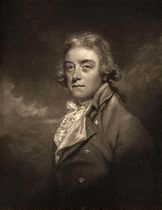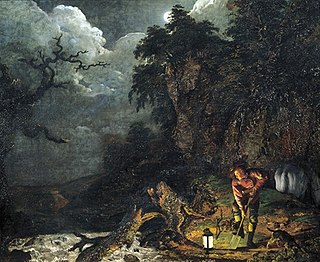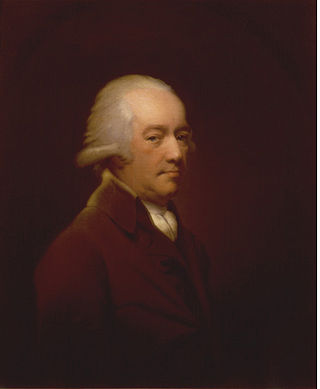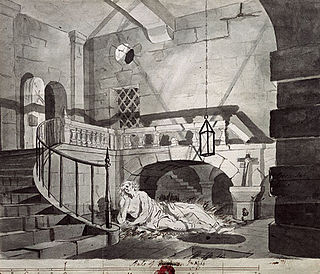
Joseph Wright, styled Joseph Wright of Derby, was an English landscape and portrait painter. He has been acclaimed as "the first professional painter to express the spirit of the Industrial Revolution".

Derby Museum and Art Gallery is a museum and art gallery in Derby, England. It was established in 1879, along with Derby Central Library, in a new building designed by Richard Knill Freeman and given to Derby by Michael Thomas Bass. The collection includes a gallery displaying many paintings by Joseph Wright of Derby; there is also a large display of Royal Crown Derby and other porcelain from Derby and the surrounding area. Further displays include archaeology, natural history, geology, military collections and world cultures. The Art Gallery was opened in 1882.

Daniel Parker Coke, was an English barrister and Member of Parliament.

A Philosopher Lecturing on the Orrery, or the full title, A Philosopher giving that Lecture on the Orrery in which a lamp is put in place of the Sun, is a 1766 painting by Joseph Wright of Derby depicting a lecturer giving a demonstration of an orrery – a mechanical model of the solar system – to a small audience. It is now in the Derby Museum and Art Gallery The painting preceded his similar An Experiment on a Bird in the Air Pump.

Meynell Langley is a small area of settlement in Derbyshire, England. It is located between Kirk Langley and Kedleston.

Sir Brooke Boothby, 6th Baronet was a British linguist, translator, poet and landowner, based in Derbyshire, England. He was part of the intellectual and literary circle of Lichfield, which included Anna Seward and Erasmus Darwin. In 1766 he welcomed the philosopher Jean-Jacques Rousseau to Ashbourne circles, after Rousseau's short stay in London with Hume. Ten years later, in 1776, Boothby visited Rousseau in Paris, and was given the manuscript of the first part of Rousseau's three-part autobiographic Rousseau Judge of Jean-Jacques. Boothby published it in Lichfield in 1780 after the author's death, and donated the document to the British Library in 1781.

Ashbourne Hall is a Manor house originally built by the Cockayne family in the 13th century in Ashbourne, Derbyshire. The present building is part of a largely demolished, Georgian-styled hall built in the 18th century.

Romeo and Juliet: the Tomb Scene is a painting by Joseph Wright of Derby, completed by 1790, exhibited in 1790 and 1791, shown in the Derby Exhibition of 1839 in the Mechanics' Institute, and now displayed in Derby Museum and Art Gallery. The painting exhibits Wright's famed skill with nocturnal and candlelit scenes. It depicts the moment in Shakespeare's Romeo and Juliet when Juliet, kneeling beside Romeo's body, hears a footstep and draws a dagger to kill herself. The line is "Yea, noise? Then I'll be brief. O happy dagger!"

Virgil's Tomb is the title of at least three paintings completed by Joseph Wright of Derby between 1779 and 1785.

Indian Widow is a painting by Joseph Wright of Derby, completed in late 1783 or early 1784 and first shown in his solo exhibition in London in 1785. The painting is since 1961 in the collection of Derby Museum and Art Gallery.

The Alchemist Discovering Phosphorus is a painting by Joseph Wright of Derby originally completed in 1771 then reworked in 1795. The full title of the painting is The Alchymist, in Search of the Philosopher's Stone, Discovers Phosphorus, and prays for the successful Conclusion of his operation, as was the custom of the Ancient Chymical Astrologers. It has been suggested that The Alchymist refers to the discovery of phosphorus by the Hamburg alchemist Hennig Brand in 1669. This story was often printed in popular chemical books in Wright's lifetime, and was widely known.

The Blacksmith's Shop is a recurring theme of five paintings by Joseph Wright of Derby. The version in his hometown was originally completed in 1771.

Earthstopper on the Banks of the Derwent is a painting by Joseph Wright of Derby originally completed in 1773. The scene shows a man digging at nighttime beside the River Derwent in Derbyshire.

Samuel Ward (1732–1820) owned property in Derby and Richmond in England. As a boy he was food taster to Bonnie Prince Charlie and was rewarded with a diamond ring which is now in the collection of Derby Museum and Art Gallery along with his 1781 portrait by Joseph Wright.

A Philosopher by lamplight is a painting by Joseph Wright of Derby. It is not known when Wright painted the picture, but it was first exhibited in 1769 in London with the Society of Artists. This was one of the earliest of many lamplight or candlelight paintings and portraits for which Wright is famed.

The Captive King is a sketch by Joseph Wright of Derby completed in 1772 or 1773. It depicts the French nobleman Guy de Lusignan held prisoner by Saladin. The sketch is thought to have been a preparation for the now-lost painting Guy de Lusignan in Prison.

The Captive, from Sterne is a painting by Joseph Wright of Derby completed in 1774 and now in the National Gallery of Canada. Sterne's Captive, first exhibited by the artist in 1778, is a similar painting by Wright in the Derby Museum and Art Gallery. The latter painting resulted in a rare engraving, as its purchaser commissioned a print run of only twenty copies before the copper printing plate was destroyed. In 2012, Derby Museum commissioned another Captive painting from Emma Tooth.

Vesuvius in Eruption is the subject of a series of thirty paintings and at least one preliminary sketch by Joseph Wright of Derby, who travelled in Italy in the years 1773-1775. It appears that whilst Wright was in Italy Vesuvius was not erupting.

Dovedale by Moonlight, 1784, is one of five paintings by Joseph Wright of Derby which uses the picturesque valley of Dovedale as its subject. These paintings were sometimes made as pairs with one showing the view by day and the other by moonlight. Wright admitted that he had not observed this scene directly, "Moon lights & fire lights are but a sort of work with me for I cant with impunity go out at night and study the former, & the latter I have seen but once, and at a time too, when I thought not of painting such effects."

Vesuvius from Posillipo by Moonlight was painted by Joseph Wright of Derby in 1774. It is an oil painting of Mount Vesuvius in the distance, from the coastal shores of Naples at night. Dark grey smoke spews from the glowing red crater of the volcano and fills up the top right of the canvas, in contrast to the pale glow of moonlight to the left. Known as a "Painter of Light," Wright liked to play with highlights and shadows in his works and was most well known for his "Candlelight Pictures," landscape or genre scenes depicting dramatic contrasts between light and dark. Through utilizing this technique, Joseph Wright exhibits the sublimity of nature in Vesuvius from Posillipo by Moonlight as well as his other paintings of Mt. Vesuvius.























